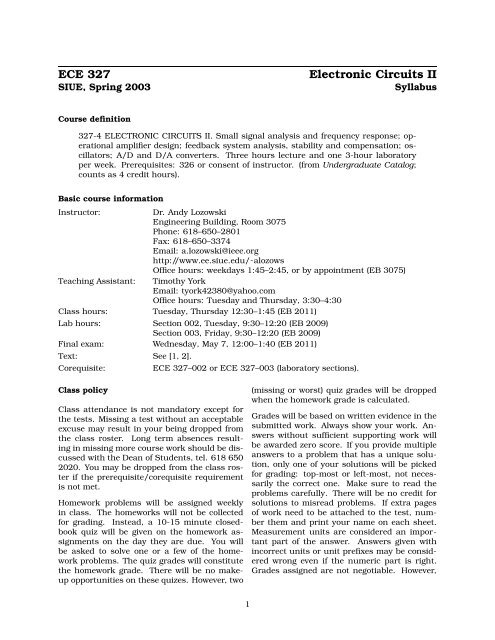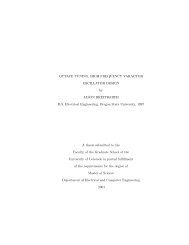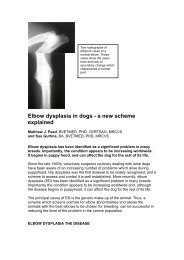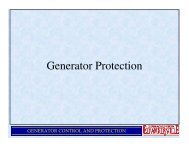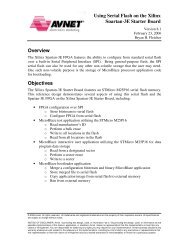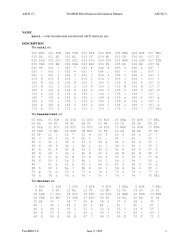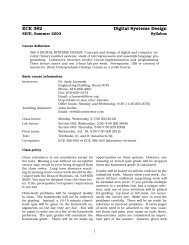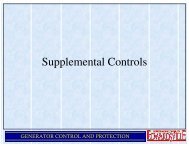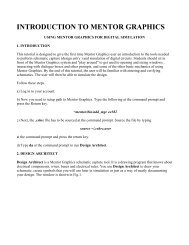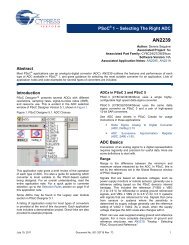ECE 327 Electronic Circuits II
ECE 327 Electronic Circuits II
ECE 327 Electronic Circuits II
Create successful ePaper yourself
Turn your PDF publications into a flip-book with our unique Google optimized e-Paper software.
<strong>ECE</strong> <strong>327</strong><br />
SIUE, Spring 2003<br />
<strong>Electronic</strong> <strong>Circuits</strong> <strong>II</strong><br />
Syllabus<br />
Course definition<br />
<strong>327</strong>-4 ELECTRONIC CIRCUITS <strong>II</strong>. Small signal analysis and frequency response; operational<br />
amplifier design; feedback system analysis, stability and compensation; oscillators;<br />
A/D and D/A converters. Three hours lecture and one 3-hour laboratory<br />
per week. Prerequisites: 326 or consent of instructor. (from Undergraduate Catalog;<br />
counts as 4 credit hours).<br />
Basic course information<br />
Instructor:<br />
Dr. Andy Lozowski<br />
Engineering Building, Room 3075<br />
Phone: 618–650–2801<br />
Fax: 618–650–3374<br />
Email: a.lozowski@ieee.org<br />
http://www.ee.siue.edu/˜alozows<br />
Office hours: weekdays 1:45–2:45, or by appointment (EB 3075)<br />
Teaching Assistant: Timothy York<br />
Email: tyork42380@yahoo.com<br />
Office hours: Tuesday and Thursday, 3:30–4:30<br />
Class hours: Tuesday, Thursday 12:30–1:45 (EB 2011)<br />
Lab hours: Section 002, Tuesday, 9:30–12:20 (EB 2009)<br />
Section 003, Friday, 9:30–12:20 (EB 2009)<br />
Final exam: Wednesday, May 7, 12:00–1:40 (EB 2011)<br />
Text: See [1, 2].<br />
Corequisite:<br />
<strong>ECE</strong> <strong>327</strong>–002 or <strong>ECE</strong> <strong>327</strong>–003 (laboratory sections).<br />
Class policy<br />
Class attendance is not mandatory except for<br />
the tests. Missing a test without an acceptable<br />
excuse may result in your being dropped from<br />
the class roster. Long term absences resulting<br />
in missing more course work should be discussed<br />
with the Dean of Students, tel. 618 650<br />
2020. You may be dropped from the class roster<br />
if the prerequisite/corequisite requirement<br />
is not met.<br />
Homework problems will be assigned weekly<br />
in class. The homeworks will not be collected<br />
for grading. Instead, a 10-15 minute closedbook<br />
quiz will be given on the homework assignments<br />
on the day they are due. You will<br />
be asked to solve one or a few of the homework<br />
problems. The quiz grades will constitute<br />
the homework grade. There will be no makeup<br />
opportunities on these quizes. However, two<br />
(missing or worst) quiz grades will be dropped<br />
when the homework grade is calculated.<br />
Grades will be based on written evidence in the<br />
submitted work. Always show your work. Answers<br />
without sufficient supporting work will<br />
be awarded zero score. If you provide multiple<br />
answers to a problem that has a unique solution,<br />
only one of your solutions will be picked<br />
for grading: top-most or left-most, not necessarily<br />
the correct one. Make sure to read the<br />
problems carefully. There will be no credit for<br />
solutions to misread problems. If extra pages<br />
of work need to be attached to the test, number<br />
them and print your name on each sheet.<br />
Measurement units are considered an important<br />
part of the answer. Answers given with<br />
incorrect units or unit prefixes may be considered<br />
wrong even if the numeric part is right.<br />
Grades assigned are not negotiable. However,<br />
1
if adjustment of grade is needed because of erroneous<br />
totaling of points, address the disputes<br />
no later than a week after the assignment has<br />
been returned.<br />
According to the Catalog, the following grading<br />
symbols are used by SIUE: A–Excellent,<br />
B–Good, C–Satisfactory, D–Poor, and F–Failure<br />
(see Academic Policies and Requirements). The<br />
letter grades will be assigned based on<br />
point scores in the following manner: A–<br />
¡£¢¥¤§¦©¨¨ ¦¨<br />
¤ !#"<br />
, B– , C– ,<br />
D– , . These thresholds<br />
may be lowered depending on the difficulty of<br />
covered topics.<br />
The final course grade will be determined based<br />
according<br />
to the following percentages:<br />
on partial scores $ , % , &(' , &*) , &*+ , and ,<br />
(Homework): -/.10<br />
$<br />
(Laboratory): -/340<br />
%<br />
-/5670<br />
) (Test 2): - 598 0<br />
&<br />
&(' (Test 1):<br />
& + (Test 3): - 59: 0<br />
2¨<br />
¨<br />
¦©¨<br />
¦©¨<br />
¦©¨<br />
¦©¨<br />
perform the experiments. The quiz score will<br />
constitute 25% of the lab grade.<br />
Experiments are to be performed individually.<br />
A written report will be collected by the TA at<br />
the end of the laboratory session. The report<br />
must be an autonomous document, i.e. it must<br />
be clear to the reader what has been done without<br />
referring to the laboratory manual. In particular,<br />
you should not use statements like: “we<br />
assembled circuit shown in page 52 and measured<br />
voltage at point F”. All relevant schematics<br />
must be included in your report and all<br />
measured voltages and currents must be labeled<br />
on your schematics.<br />
Your TA will grade the reports and submit them<br />
to the instructor. The instructor will review the<br />
grades and may change them. In particular,<br />
the instructor will check the reports for completeness<br />
and the level of professionalism in<br />
the write-up. Reports will be reviewed to assess<br />
achievement of the following educational<br />
goal: “Students will obtain an ability to express<br />
ideas effectively in both oral and written communication.”<br />
, (Final exam): -/; :<br />
&(' , &*) , &=+ , and ,<br />
>0<br />
8 &*)©AC-D5 : &*+©AC- ; ,<br />
-/.@$BAC-D3*%EAC-D56&('FAC-D5<br />
8 AH-/5 : AH- ;<br />
-D.GAH-/3IAC-D56JAC-D5<br />
The final grade will be an A, B, C, D, or F based<br />
on the grade point > score . Note that the above<br />
equation can be used to determine the grade “to<br />
date” if the percentage for unassigned grades<br />
are set to zero. There will be no extra credit<br />
available. Work on your grades throughout the<br />
semester.<br />
Lab Policy<br />
The hardware laboratory will consist of preliminary<br />
work, experimental work, and reports.<br />
You are expected to have read through the<br />
entire assignment in the lab manual prior to<br />
coming to the lab. You may have insufficient<br />
amount of time to complete the experiment<br />
if you fail to do so. Make sure to solve all<br />
the problems assigned in the section entitled<br />
“Preparation” in the relevant sections of the lab<br />
manual. Quizes will be given before every experiment<br />
to verify that you have done the preliminary<br />
work and have knowledge sufficient to<br />
One (worst or missing) lab grade will be<br />
dropped when the final lab grade is calculated.<br />
After completion of the lab experiment, the<br />
work station must be left in a state no worse<br />
than it was upon arrival to the laboratory. No<br />
items such as parts, wires, bags, etc..., can<br />
be left in the lab after use. All instruments<br />
must be turned off (unless otherwise noted).<br />
Also, all the equipment moved for the needs<br />
of experiment must be put back in its original<br />
place. This includes probes and cables. No circuits<br />
may be left on the CADET bread-boards.<br />
If the CADET bread-boards were pre-wired for<br />
the power supply distribution (+,-,GND), these<br />
wires should stay intact. At any time, unoccupied<br />
workstations left with circuits labeled “do<br />
not dismantle” may be cleaned-up by a TA or<br />
faculty inspecting the lab and reported to the<br />
lab manager for disciplinary actions.<br />
References<br />
[1] A. Sedra and K. Smith, Microelectronic <strong>Circuits</strong>.<br />
Oxford University Press, 4 ed., 1998.<br />
[2] K. C. Smith, Laboratory Explorations. Oxford<br />
University Press, 4 ed., 1998.<br />
2


